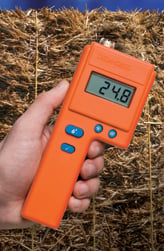High quality hay is valuable hay. High quality hay needs to be baled at appropriate moisture levels to prevent spoilage, yet moist enough to prevent shattering losses, and is free of foreign matter, weeds and molds. Therefore, measuring moisture in hay is crucial for good quality and value.
Quality hay relies heavily on maintaining proper moisture levels for safety and good nutritive content. Tips for high quality hay include:
- Cutting at the proper stage of maturity
- Promoting rapid dry-down
- Maintaining high leaf content
- Timely baling at the right moisture content
Most plants are almost 80% water and continue to metabolize cellular carbohydrates and sugars until the moisture levels in the forage reach 40%.
Excess moisture levels in hay that delay drying and promote valuable energy losses might be due to:
- Tight windrows
- Moist soil
- Cloudy, high humidity conditions
Harvesting practices to increase hay quality include:
- Cutting in the afternoon
- Laying hay down on dry ground or stubble to prevent soil moisture from rising into the windrow
- Raking operations that do not cause leaf loss
- Baling at the right moisture levels
Correct Moisture Levels for Baling Hay
Maintaining high quality hay means careful monitoring of moisture levels to ensure that it’s dry enough for storage. If hay is baled at too high a moisture level, bale heating occurs shortly after harvest. When moisture levels are just a bit too high, hay can quickly degrade and/or suddenly burst into flames by spontaneous combustion. Excess moisture creates a friendly environment for the growth of micro-organisms such as bacteria and fungi. When moisture levels are below about 14%, bacteria and fungi are not able to reproduce, thereby reducing the risk of spontaneous combustion.
Protect Quality with a Hay Moisture Meter
The degradation of hay from fungal growth begins with excess moisture, but allowing too much drying time can also adversely impact the quality of hay. Monitoring moisture is the key to maintaining quality and value. However, certain types of hay--rye grass in particular--may feel dryer than they actually are, making it difficult to tell exactly when hay is ready and safe for storage. Therefore, obtaining accurate moisture readings is the only way to know the optimal time for storage.
A hay moisture meter may be used to verify that moisture levels are no higher than 15-20% before baling. A good quality moisture meter such as the F-2000 from Delmhorst is also helpful after baling to monitor the internal moisture of the bale.
How to Use a Hay Moisture Meter
Proper testing procedures are critical to protecting your hay quality. Internal moisture will vary from place to place within a bale, and variations in density may impact the accuracy of readings. Obtaining accurate results from baled hay requires testing multiple spots and averaging readings. Likewise, hay that is tested before baling must be mixed and retested multiple times to ensure accuracy.

FX-2000
Since hay moisture is measured at different times and in different ways such as in individual bales, stacked bales, etc., hay moisture measuring devices have useful attachments. The attachment, or electrode, can test deep into bales, in the windrow, or while baling. When shopping for hay moisture measuring equipment consider the attachment best suited to your needs. Frequently the attachments are packaged with the meters in carrying cases so everything you need is conveniently stored in one place.
While getting an accurate read on the moisture level in hay and monitoring changes in temperature during the early stages of storage requires a bit of work and a lot of care, it’s well worth the effort. Storing hay with higher-than-recommended moisture content can destroy it’s quality and worse. High levels of moisture in hay which lead to fungal growth can also result in spontaneous combustion. In that case, a farmer may find himself not just with a lower quality product, but with no product at all. Obtaining and correctly using a hay moisture meter is a solid investment for anyone wanting to protect their revenue source when working with hay.
CARE OF YOUR METER
Keeping your Delmhorst moisture meter in good working order is one of the easiest ways to ensure your moisture tester keeps giving you accurate results. Here is what you need to do:
- Store your meter in a clean, dry place. The optional protective carrying case is an ideal storage place when the meter is not in use.
- Change the 9-Volt battery as needed. Continued use with a low battery may cause the meter to go out of calibration.
- Clean the meter and probe with any biodegradable cleaner. Use the cleaner sparingly and on external parts only. Keep cleaner out of the external connector. Do not immerse the meter or any prod in water.
- Remove the battery if the meter will not to be used for one month or longer
For more information about which moisture meter and/or attachments are best for your job, contact our specialists at: 877-DELMHORST (877-335-6467)
To learn more about correctly using a moisture meter for hay, login to view Delmhorst’s F-2000 training video.
Comments